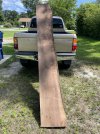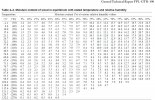I just got a walnut slab yesterday locally that has been air dried for about 8 years (or so they say). The slab is approximately 6/4 thick, 10’ long, averages 13” wide, and the moisture content is around 12% according to my meter checked in several places. My garage/shop isn’t insulated or conditioned, so I doubt the moisture content will change much but I still plan on letting it sit in the shop for a week or so before using it.
Would cutting the slab into two 5’ pieces be ok to do at this point? Would it help it acclimate faster, or introduce possible problems? I will be using the slab to make a desk. My thinking was that by cutting it into two pieces I would be able to bring it into the house to sit and acclimate where the desk will eventually be. Good idea or no?
This is my first time working with a slab and with anything air dried, so any comments, recommendations, general knowledge is much appreciated.
Would cutting the slab into two 5’ pieces be ok to do at this point? Would it help it acclimate faster, or introduce possible problems? I will be using the slab to make a desk. My thinking was that by cutting it into two pieces I would be able to bring it into the house to sit and acclimate where the desk will eventually be. Good idea or no?
This is my first time working with a slab and with anything air dried, so any comments, recommendations, general knowledge is much appreciated.


